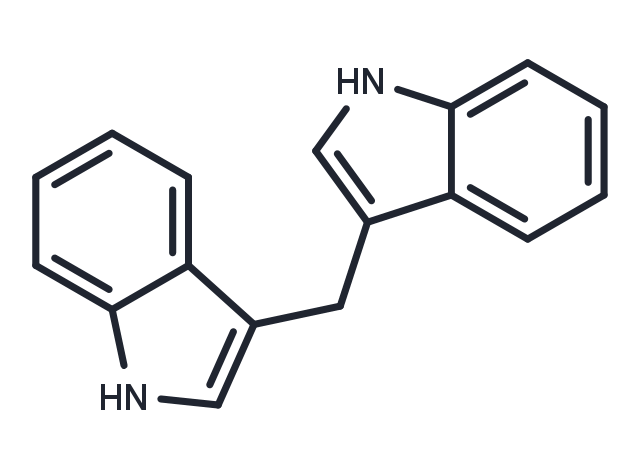Powder: -20°C for 3 years | In solvent: -80°C for 1 year


3,3'-Diindolylmethane (DIM), a small molecule compound, is a proposed Y preventive agent.

| Pack Size | Availability | Price/USD | Quantity |
|---|---|---|---|
| 50 mg | In stock | $ 39.00 | |
| 100 mg | In stock | $ 53.00 | |
| 200 mg | In stock | $ 62.00 | |
| 500 mg | In stock | $ 81.00 | |
| 1 mL * 10 mM (in DMSO) | In stock | $ 57.00 |


| Description | 3,3'-Diindolylmethane (DIM), a small molecule compound, is a proposed Y preventive agent. |
| In vitro | DIM is a potent radioprotector and mitigator that functions by stimulating an ATM-driven DDR-like response and NF-κB survival signaling. DIM can inhibit invasion, angiogenesis, and proliferation and induce apoptosis in tumor cells by modulating signaling pathways involving AKT, NF-κB, and FOXO3. It can also inhibit estrogen-inducible gene expression and cause an endoplasmic reticulum stress response. DIM alters estrogen metabolism by shifting metabolism from carcinogenic 16α-hydroxy to inert 2-hydroxy derivatives, and it antagonizes estrogen and androgen receptor activity[1]. |
| In vivo | Preliminary studies show DIM is most effective against total body irradiation (TBI) when given in multiple once-daily doses. Treatment of DIM has radioprotection and mitigation properties in vivo. DIM Activates ATM in Normal Tissues. DIM can be given to mice (250 mg/kg) by oral gavage, with no acute toxicity and excellent bioavailability[1]. |
| Cell Research | The 184A1 and Hs578Bst cells are pretreated with DIM (0.3 μM) or vehicle for 24 h, irradiated by using different doses of 137Cs γ rays, harvested, plated at different densities, incubated for 14 d, and counted for colony formation.(Only for Reference) |
| Synonyms | HB 236, DIM, Arundine |
| Molecular Weight | 246.31 |
| Formula | C17H14N2 |
| CAS No. | 1968-05-4 |
Powder: -20°C for 3 years | In solvent: -80°C for 1 year
Ethanol: 18 mg/mL (73.08 mM)
DMSO: 24.6 mg/mL(100 mM)
You can also refer to dose conversion for different animals. More
bottom
Please see Inhibitor Handling Instructions for more frequently ask questions. Topics include: how to prepare stock solutions, how to store products, and cautions on cell-based assays & animal experiments, etc.
3,3'-Diindolylmethane 1968-05-4 Autophagy Endocrinology/Hormones Androgen Receptor HB 236 Inhibitor 3,3' Diindolylmethane HB-236 DIM HB236 3,3'Diindolylmethane inhibit Arundine inhibitor
